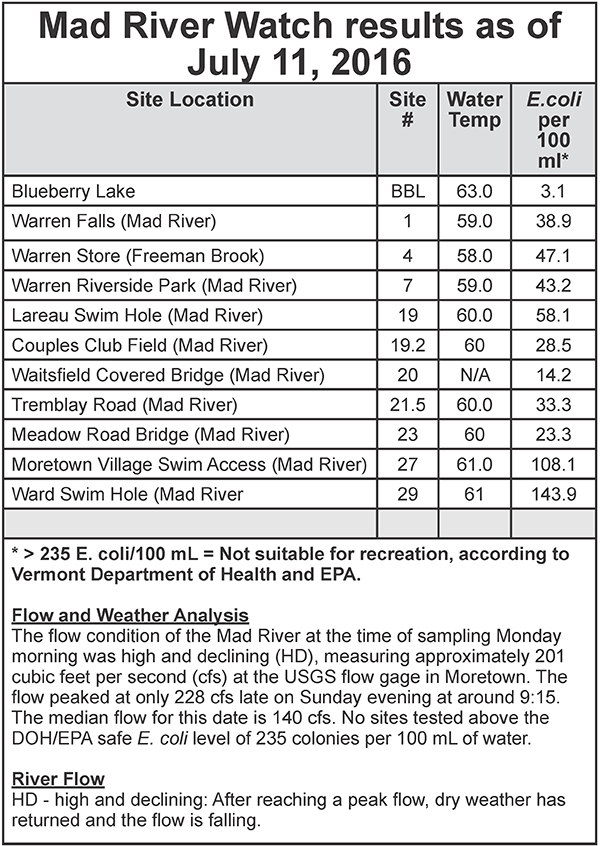Sampling results from the third round of Friends of the Mad River’s Mad River Watch Program show no sites with unfavorable swimming conditions as of July 11. After a weekend of intermittent and scattered showers, the water on Monday morning at the time of sampling was declining. Prior to Monday’s sampling, sediments and pollutants from the land into the river and streams had likely already flushed through the watershed and onto the Winooski River and Lake Champlain.
The flow condition of the Mad River at the time of sampling Monday morning was high and declining (HD), measuring approximately 201 cubic feet per second (cfs) at the USGS flow gage in Moretown. The flow peaked at 228 cfs on Sunday evening at around 9:15 p.m. This “high” flow level is relative to the normal this time of year. The median flow for this date is 140 cfs.
Rains can cause E. coli levels to fluctuate, even on an hourly basis, as water carrying pathogens moves down the watershed. The Friends of the Mad River E. coli sampling results are a snapshot in time intended to give people a sense of the conditions that lead to high pathogen levels in the water.
“You and your good judgment are your best protector -- use common sense and don't swim for at least 24 hours after a substantive rain. It is estimated that at the level of 235 colonies E. coli per 100 mL water, approximately eight out of every 1,000 swimmers are likely to contract a waterborne illness related to fecal contamination,” said Friends of the Mad River executive director Corrie Miller.
This week’s Mad River Watch volunteers included Charlie Baldwin, Richard Czaplinski, Susy Deane, Chase Fortier, Kinny Perot, Fran and Gary Plewak, and Michael Ware. Susanne and George Schaefer drove water samples to the lab in Burlington for phosphorus, nitrogen and turbidity analysis. Sally Boudreau posted data at swim holes across the watershed. Paula Baldwin has taken over the helm as lab coordinator this year.
“The river connects our Mad River Valley community and its clean water is a measure of our success as stewards of the land. For more information about E. coli and the Mad River Watch program and to view our most recent complete data report please visit the Friends of the Mad River website at www.FriendsoftheMadRiver.org. Results are also available on Facebook (“Friends of the Mad River”) and on sign posts at swim holes across The Valley,” Miller said.






